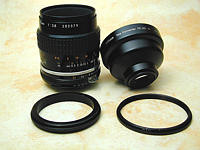
|
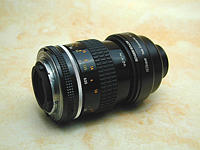
|
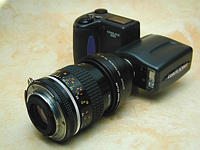
|
| Lens and rings | Connecting the lenses | Installing the combo on camera |
| Click on the image to see a larger one | ||
We all know that close-up photography requires the close-up setting of 950/990 (i.e., the flower icon) and/or the use of a close-up filter (i.e., diopter). But, the magnification power is still not high enough even with the already good 950/990 close-up capability. If you do 35mm close-up photography, you perhaps know that reversing a lens can deliver higher magnification. Moreover, attaching a reversed lens on a lens permits us to achieve even higher magnification. The reversed lens actually serves as a high magnification diopter with a diopter power being equal to the quotient of dividing 1000mm by the focal length of the revered lens. For example, a reversed 50mm lens serves as a diopter of magnification power +20 (=1000/50). You cannot find such a high power and high quality diopter on the market. In fact, the most popular diopters have power +1, +2, +3 and +4. So, if you have a flat-field, high quality 35mm lens. you have already owned a high power diopter!
If we can screw a diopter on a camera lens for close-up work, we could also install a reversed lens on a 950/990! This is the key point! Let us call the on-camera one the prime lens. If the prime lens and reversed lens have focal lengths m and n, respectively, then the magnification power is m/n. Therefore, to achieve high magnification, the prime lens should have a focal length larger than that of the reversed lens. For example, if the prime and reversed lenses have focal lengths 200mm and 50mm, the magnification power is 4 (=200/50).
For a 950 or 990, the longest focal length we can get as of this writing is 48mm = 2×24mm, which is obtained by using the TC-E2 tele-converter. We can choose 48mm as the focal length of the prime lens. As for the reversed one, a 35mm normal lens (i.e., focal length 50mm) should work fine and delivers a magnification power of 48/50=0.96X. This means the size of a subject on the image sensor is 96% of the real subject length. Thus, this setup is capable of life-size close-up. Good choices for the reversed lens include 24mm f2.8, 35mm f2 and 50mm f1.8 because of their edge-to-edge quality. Note that all lens mentioned above are Nikon's AI Nikkor. The 55mm f2.8 Micro Nikkor is another excellent option.
If you have TC-E2 and a normal lens (does not have to be a Nikkor), you are almost there. What you need are two rings. The first one is frequently referred to as a macro coupler. It is simply a doubly threaded male ring so that you can screw lens on both threads. The TC-E2 has thread size 62mm, and most manual focus shorter focal length Nikkors have thread size 52mm. However, since macro couplers of 62mm-52mm perhaps do not exist, we have to use a properly chosen macro coupler and a step-down ring. The examples on this page use a 55mm f2.8 Micro Nikkor with 52mm filter thread. So, I use a 62mm-58mm step-down ring and a 58mm-52mm macro coupler as shown in the first image below, where the thin ring next to the TC-E2 is a 62-58 step-down ring and the other is a 58-52 macro coupler. Please note that there are many alternatives to achieve the same goal and the one shown here is definitely not the only way. For example, you can use a 62-52 step-down ring and a 52-52 macro coupler.

|

|

|
| Lens and rings | Connecting the lenses | Installing the combo on camera |
| Click on the image to see a larger one | ||
Joining all four items together gives a big lens as shown in the middle image. Finally, screw this big lens onto the on-camera lens. See the right image above.
The following shows some sample images. These images are used to show the close-up capability of this combo rather than demonstrating any artistic work.
The following shows the image of the tip of a ball-pen. The left one is taken with 990's minimum focus distance under the macro mode (i.e., 2cm). The middle image is taken using the combo with the reversed lens (i.e., 55mm Micro Nikkor) set to minimum focus distance, while the right one is set to infinity. In both cases, the on-camera lens is zoomed all the way in to maintain a focal length of 48mm, and magnification power 48/50 = 0.96X. The magnification of the last two images do not have significant difference, and, as a result, the reversed lens is always set to infinity for taking all subsequent sample images. This is an advantage because the lens tube is shorter when focused to infinity and thus lighting is easier. Note that the 55mm Micro Nikkor is not an internal focus lens, and focusing causes the length of the lens tube to change. However, vignetting does occur, and has no way to prevent!

|
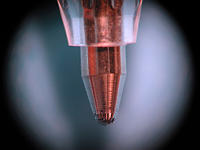
|
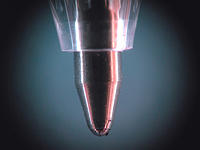
|
| 990 macro | Min focus distance | Focus at infinity |
| Click on the image to see a larger one | ||
The next three sets of images show some other examples. Images on the left column are taken with 990's macro capability at the shortest focusing distance (i.e., about 2cm) with focal length set in the middle (i.e., flower icon turns yellow). Images on the right column are taken using the combo with the reversed lens focusing to infinity. It is obvious that the combo delivers higher magnification than the on-camera lens.
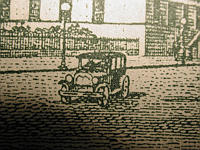
|
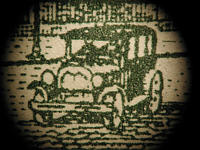
|
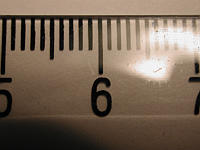
|
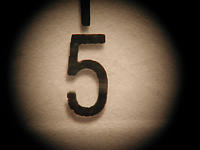
|
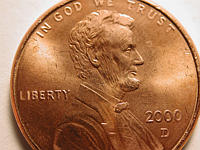
|
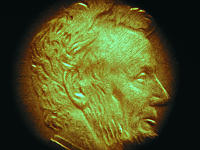
|
| 990 close-up | 990 with TC-E2 and reversed lens |
| Click on the image to see a larger one | |
Here are my conclusions:
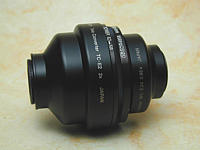
|
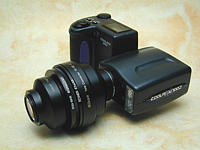
|
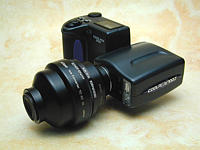
|
| The E2 and E24 combo | Reversed WC-E24 | Revered TC-E2 |
| Click on the image to see a larger one | ||
Both versions have vignetting problem and poor optical quality. The optical quality of the reversed WC-E24 version is so poor that I do not even want to show any image here. Images taken with the reversed TC-E2 version are soft. Sharpness of the center portion is acceptable, but deteriorates quickly. Because WC-E24 has high field curvature which is magnified by the TC-E2, the images look like the ones taken using a fisheye converter. The following is an example. Please note that it only "looks" like an fisheye image, and is not equivalent to using a fisheye converter because the angle of view is less than 180 degree.
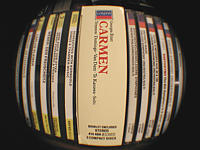
|
||
| Poor result from reversed TC-E2 | ||
| Click on the image to see a larger one | ||